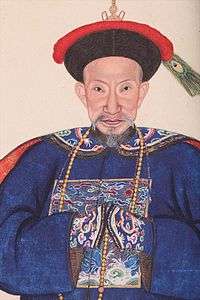Sun Shiyi
Sun Shiyi (simplified Chinese: 孙士毅; traditional Chinese: 孫士毅; pinyin: Sūn Shìyì; Wade–Giles: Sun Shih-i, Vietnamese: Tôn Sĩ Nghị; 1720 – 1796), courtesy name Zhizhi (智冶), pseudonym Bushan (補山), was an official of the Qing dynasty who served as the Viceroy of Liangguang[1] and of Liangjiang during the reign of the Qianlong Emperor.[2]

A native of Renhe (present-day Yuhang District, Zhejiang), as a youth, Sun was devoted to study and was said to have prevented drowsiness by knocking his head against a wall. Awarded a jinshi degree in the imperial examination in 1761, he was secretary to Fuheng during his Burmese expedition, and in 1770 had risen to be Treasurer of Guangxi, when he was cashiered for want of energy, and orders were given to confiscate his property. Struck with the fact that nothing was found to confiscate, the Qianlong Emperor re-employed him.
In 1788, as Viceroy of Liangguang, he invaded Annam and reinstalled the emperor Lê Chiêu Thống, who had fled in fear of the rebel Nguyễn Huệ. No sooner had the Chinese withdrawn than another revolution took place, and it was ultimately decided to leave Annam alone. He was sent to Sichuan to see the supplies of the army fighting in Tibet, into which country he advanced over terrible mountains as far as Chamdo. In 1792, on the conclusion of the war with Nepal, the suppression of the White Lotus Rebellion occupied his last days. His physical powers were marvellous, and he required hardly any sleep. He was a great collector of ancient inscriptions. He was ennobled as Duke Mouyong of the First Class (一等謀勇公).[3]
References
- Ownby, David (1996). Brotherhoods and secret societies in early and mid-Qing China: the formation of a tradition. Stanford University Press. pp. 111–113. ISBN 978-0-8047-2651-1.
- Truhart, Peter (2000). Regents of nations: systematic chronology of states and their political representatives in past and present : a biographical reference book, Volume 3. K. G. Saur. ISBN 978-3-598-21545-2.
- Herbert Allen Giles, A Chinese Biographical Dictionary, p. 694. (1898).
Further reading
- Iona Man-Cheong (2004). The class of 1761: examinations, state, and elites in eighteenth-century China. Stanford University Press. pp. 180–200. ISBN 978-0-8047-4146-0.
| Government offices | ||
|---|---|---|
| Preceded by Suchang |
Viceroy of Liangguang 1786─1789 |
Succeeded by Fuk'anggan |
| Preceded by Shulin |
Viceroy of Liangjiang 1790─1791 |
Succeeded by Shulin |